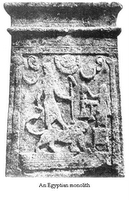Archaeologists have unearthed a large number of artifacts in which a deity with a crescent moon on top of its head symbolized worship of the moon god. According to archaeological discoveries, the Islamic god, ‘Allah,’ originates from the ancient Arab moon god known as ‘Allah.’ This is a surprise to many, for most Muslims and non-Muslims alike are under the impression that ‘Allah’ is an Islamic name for Yahweh/Jehovah. Modern day Muslims have been unwittingly deceived.
In reality, according to archaeological and historical records, Allah was the moon god married to the sun goddess, and together they had three daughters: goddesses Al-Lat, Al-Uzza, and Manat. (The first two names are feminine forms of ‘Allah’). The worship of these three goddesses played a major part in the worship at the Kabah in Mecca. The pagans prayed toward Mecca and the Kabah because that is where their gods were stationed. The worship of the moon god extended far beyond the Allah-worship in Arabia. The entire Fertile Crescent was involved in the worship of the moon.

This partially explains the early success of Islam among Arab groups that traditionally worshiped the moon god. Since the idol of their moon god, Allah, was at Mecca, they prayed toward Mecca. Archaeologists have discovered temples to the Moon-god throughout the Middle East. Evidence shows the temple of the Moon-god was in full swing even during the Christian era.
According to numerous writings the actual name of the Moon-god was ‘Sin,’ but his title was Al-iIah, which means ‘the deity,’ the most superior of all other gods. The Moon-god's title ‘Al-iIah’ was condensed to ‘Allah’ before the Islamic religion came to be. The pagan Arabs used ‘Allah’ in the names they gave to their children. The Quraysh tribe into which the Muslim prophet Muhammad was born was particularly devoted to Allah, the moon god, and especially to Allah's three goddess daughters who were viewed as intercessors between the people and Allah. This may explain why both Muhammad's father (Abd-Allah) and uncle (Obied-Allah) had ‘Allah’ as part of their names, showing the devotion that Muhammad's family had to the worship of the moon god.
The symbol of the worship of the moon god in Arabian culture and elsewhere throughout the Middle East was the crescent moon. Interestingly, the symbol of Islam is also the crescent moon; a crescent moon sits atop their mosques, is found on the flags of Islamic nations, and the Muslims fast during the month of Ramadan, which begins and ends with the appearance of the crescent moon.
While devout modern Muslims believes the rituals and doctrines of Islam are entirely heavenly in origin and thus cannot have any earthly sources, Middle East scholars have demonstrated beyond all doubt that the rituals and beliefs in Islam can be traced back to pre-Islamic Arabian culture.


1 comments:
The position of the hands on the moon-god tablet reflect the way muslims, during standing prayer, hold their hands, palms up, infront of their faces. Moon-god ritual is clearly still practiced.
Post a Comment